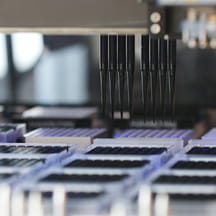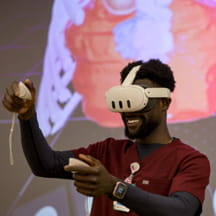Pediatric heart transplants are one of the most challenging surgeries to coordinate. A team of cardiologists and researchers from Cincinnati Children’s is using emerging technologies to more effectively match heart donors with recipients.
Current heart transplant methods are inefficient, labor-intensive
Traditionally, cardiologists have assessed heart transplant compatibility by comparing the height and weight of the donor child to the transplant patient. It is an inexact science, which can lead to unnecessarily rejected matches. In recent years, they have used MRI or CT scan images to calculate Total Cardiac Volume (TCV). This method more accurately matches donors and recipients, but it is a manual, labor-intensive process.
“Currently, it takes us about 30 minutes to download and process over 300 images to calculate a 3D heart volume,” said Ryan Moore, MD, MSC, director of Digital Health Innovation at the Heart Institute and department of information services, and medical director of Digital Experience Technologies at Cincinnati Children’s. “When you get that call — especially in the middle of the night — 30 minutes is not ideal. There’s only a certain amount of time for surgeons and transplant teams to make a decision.”
Enhancing heart transplant accuracy in a fraction of the time
Moore, along with David Morales and a team of researchers, is studying deep learning’s accuracy in analyzing cardiac images. Deep learning is an artificial intelligence (AI) technique where machines are programmed to mimic the decision-making characteristics of the human brain, so it’s well suited for the task of calculating TCV. A deep-learning AI model can accomplish in seconds what takes a cardiologist 30 minutes. The group’s research aims to improve mortality rates among pediatric heart transplant patients by enabling faster and more accurate TCV calculations in all transplant centers.
One of the primary challenges is building the complex AI models needed to complete these tasks. Moore brought the concept to Nvidia, a technology company, who introduced the team to Project MONAI (Medical Open Network for Artificial Intelligence), a set of open-source, freely available collaborative frameworks built for accelerating research and clinical collaboration in medical imaging. MONAI’s application packages make it feasible to integrate AI modeling into clinical workflows. But implementing the application packages still requires some heavy lifting.
“There has to be somebody who figures out how to integrate this and implement it into clinical practice — remove those barriers and make it plug and play,” Moore said. “We're trying to go through those painful processes so everybody else can benefit down the road as we figure out how to deploy it.”
The technology’s benefits are promising. In the group’s recently published study, deep-learning-generated TCV identified matches with 94.5% accuracy — equally as accurate as manual identification. Importantly, the model's accuracy was consistent across different ages, weights, and heights of subjects.
“Using total cardiac volume and AI, we can increase the number of acceptable donors for patients waiting for hearts and have already started to demonstrate that this system can improve survival on the waitlist and perhaps even after transplant,” said Morales, MD, executive co-director of the Heart Institute and director of the division of cardiothoracic surgery and James Scott Tweddell Chair of Congenital Heart Surgery at Cincinnati Children’s. This work is supported by a National Institutes of Health grant led by Morales.
What children’s hospitals can do
Meanwhile, Moore and his team continue to gather more cardiac scans to validate their ongoing research. When the models are ready for wider clinical use, they’ll deploy them through Nvidia’s federated learning network, a collaborative approach that will allow the development of machine learning models without compromising data security or privacy.
Once the models are deployed, children’s hospitals will need to figure out how to implement them with their technology, Moore said. Having a dedicated data scientist on board is crucial to integrating complex technological solutions into clinical practice. Beyond that, leveraging the expertise and experience of institutions such as Cincinnati Children’s can help bring life-saving technology to children everywhere more quickly.
“We want to create a kind of learning network where we can help other institutions learn how to adopt new technologies,” Moore says. “We want to know how we can help spread these solutions — that’s a big need right now.”


